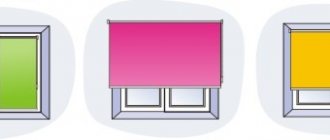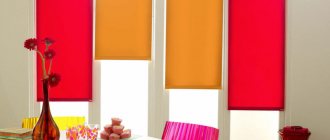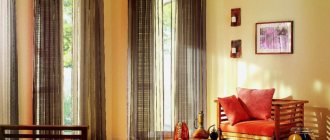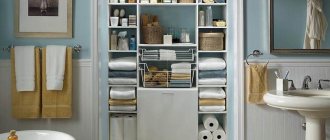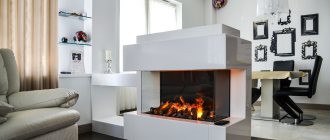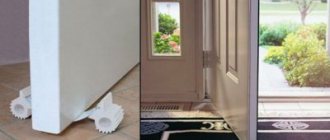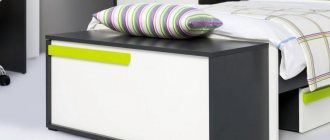The history of using drum-type window curtains goes back a long way. The mystery of the popularity of such designs lies in their practicality and ease of management. Over time, they learned to make roller blinds aesthetically attractive, and not just utilitarian. This has given rise to a wide variety of models. And if Roman blinds create coziness, then roller blinds have greater functionality, although a number of models are not inferior in terms of design and harmony.
Roller blinds are easy to use, look stylish and modern
Roller blinds: types and features
The operating principle of these convenient curtains is reminiscent of Roman designs and horizontal blinds. Now this version of curtains in combination with the usual curtains is common for apartments and private houses, as well as in business centers. They create a barrier to excessively bright natural light, which not only can interfere with relaxation, but also affects the preservation of the color of the wallpaper and the interior decor.
You can choose rolled products that are suitable in price depending on the purpose
There are several types of roller blinds. Their diversity lies not only in the control method, but also in system features. There are two main types:
- Open control mechanism.
The roller is within visible reach and is not protected by a cassette or other type of casing. Open type roller blind - Closed control mechanism. The roller is hidden under a housing that secures the canvas quite rigidly and prevents it from crumpling or sagging. The product takes on a more complete and aesthetic appearance.
Roller blind with protective box
The operating principle of the design may also vary. There are 3 control options:
- using chains;
- by electric drive;
- using a spring holder.
Roller blind with chain Curtains with spring mechanism
Electric roller blinds
All methods are convenient in their own way. When choosing curtains, focus on many criteria that are individual for each place and lifestyle.
There are 4 types of fabric used indoors:
- completely transparent;
- dimout (light transmission 20-30%);
- blackout (100% opacity);
- "day Night".
Transparent roller blind Dimout roller blind
Blackout roller blinds
Roller blinds day-night
Translucent fabrics are used, as well as non-textile materials (bamboo, jute, etc.), which have their own degree of light transmission depending on the model.
On a note! Many options for curtains (plastic, metal or wooden box/roller) of any color, including white, allow you to choose the one that suits your decor.
Rope type
A mechanism of this kind is the simplest and consists of several elements:
- Rope. It connects to the main ropes in the horizontal blinds.
- Video clip. With its help, force is transmitted from the control thread to the web frame.
The adjustment process is quite simple and involves shortening the length of the threads that are located between the individual elements. In this case, the canvas is simply compressed into a kind of accordion. If this approach is applied to a single sheet of fabric, then folds form on its surface. This type of blinds is called Roman blinds.
You can easily build a rope mechanism yourself. To do this, rings are sewn to the sides of the fabric through which the threads are passed. The latter are attached to the bottom of the curtain.
Height adjustment is carried out by uniformly pulling up the bottom layer of the fabric and fixing the supporting thread on special hooks.
Advantages and disadvantages of roller blinds
When preparing to choose a model, you should pay close attention to the advantages and disadvantages of this type of structure.
Roller blinds can be matched to various interior styles
The advantages of roller blinds are as follows:
- Versatility. Possibility of combining models with many interior styles.
- Aesthetics and conciseness. Strict forms in combination with high-quality fabric can transform a living space, attic or loggia into a modern look.
- Practicality. Curtain maintenance is minimal.
- Reliability. High-quality products have a large margin of safety.
- Functionality. With the help of roller blinds you can provide any level of light access to the room.
- Electrically driven models allow you to control them from a distance (for example, while lying in bed).
- Replacement of curtains. Roller blinds go well with tulle, so there is no need for full-fledged curtains.
- Space saving. Such a curtain does not require the construction of curtains extending beyond the window.
- Low cost. You can choose a budget model with a beautiful design.
- For convenience, products are always accompanied by instructions for assembly and operation.
The roller blind fabric can be plain or patterned
The disadvantages of roller blinds are minimal. These include:
- minimalism (not always combined with classic style interiors);
- require special installation for plastic windows and structures with vents (rather not a minus, but a feature).
Location options
It's always good to have more than one option. In the case of the arrangement of roller blinds, there can be at least four such options. The choice of location of curtains is influenced by several criteria: the design of the curtain itself, the size of the window, design features, and simply personal preferences.
Roller blinds and Roman blinds are very similar in appearance, but differ in the opening mechanism.
So, options for placing roller blinds:
- Wall above the window. This is an ideal way to place curtains for small windows and when there is no window sill. It is better to give preference to a long cornice, and then visually the window will appear larger.
- Ceiling. This is also an option for small window openings.
- Window hole. If you are looking for an option for office windows, or for sliding structures, then take a closer look at this particular option for placing roller blinds. You will have the opportunity to completely close the window opening; you will not have to use additional tulle. The result is a stylish and functional window design.
- Frame. A window that is too wide or a window opening that is too deep are “indications” for installing roller blinds on the frame. As a result, you get a free window sill and a harmoniously designed window. By the way, fastening to the frame is also ideal when the sashes are solid and you don’t have to open and close the window or window.
- Casement windows. In this case, roller shutters are attached to the opening windows. Most often, such fasteners are used when the window is additionally decorated with tulle, although this is not necessary. These “mini” models are very similar to regular blinds, but are much more practical in operation.
Design and principle of operation of roller blinds
The bobbin type of design involves the presence of several components. Roller blinds include:
- roller with control unit;
- canvas;
- weight plumb line;
- guides;
- adjustment mechanism.
Roller blind device with body and side guides
Roller blinds work on the principle of winding and unwinding the fabric onto a drum. It is located at the top of the structure. To tension the web from below, there is a weighting agent - U-shaped or a bar, with the help of which the roll does not sag or warp.
The classic mechanism is controlled via a chain. In modern models you can sometimes find magnetic stoppers.
To limit travel, a stopper is installed on the chain
The mechanism, controlled by a chain drive, has its own peculiarity. The balls on the cord are part of the hinge structure when the roller rotates in one direction or another. They also act as a kind of fixative. The finished sample has a chain descent of at least 2/3 of the length of the blade.
Roller blinds are convenient, rising from bottom to top using a spring mechanism. They have good tension. A reliable spring cushions the blade, which can be fixed in the desired position.
Interestingly, curtains with a spring mechanism can be installed in different positions
Roll winding can be direct or reverse. The second option is typical for cassette curtains.
The guides help to distribute the canvas evenly when scrolling. They also cover the sides from gaps.
Cassette roller blind with side rails
Making stained glass models
To create them, you can use any material, even tulle. The peculiarity of their appearance is that they resemble an hourglass. The canvas can be assembled with a transverse belt at any level. The essence of assembling a stained glass curtain with your own hands is to install the upper and lower guides and stretch the fabric between them. Wooden planks, metal tubes, string or thick fishing line can be used as guides.
The choice of material tension option affects the removal of vertical and horizontal dimensions:
- Having measured the distance between the upper and lower holders, you need to add another 20 cm. If the fabric is stretchy, then the allowance should be reduced.
- To avoid mistakes, you can make a top pocket and immediately put it on the barbell. Then pull it to the bottom crossbar, grab it with a drawstring and mark the length.
- If everything suits you, sew the bottom and put it on the holders.
- The width depends on the type of material and the desired splendor. Therefore, take either 1.5 of the opening size or double the size, adding a couple of centimeters on each side.
You can also use the patchwork method, but first you need to choose a stained glass pattern. Sewing a simple mosaic version of curtains begins with sewing together a patchwork of multi-colored stripes. Then the finished canvas is cut at an angle of 45 degrees into strips. The connection of the resulting strips is stitched with an offset by the selected number of diamonds. This method can produce any pattern, and the fabric is exclusive.
Mini roller blinds for fixed windows
Fully closed doors sometimes require a uniform design in the form of roller panels. When decorating such openings, you can use curtains with mini-rollers.
The kit includes a roller rod, brackets, fishing line and clamps. To secure a curtain to a blind window, you need to do the following:
- Determine the size of the future roll by width and length.
- Connect the roller and the canvas as indicated in the instructions.
- Secure the open drum or cassette to the brackets using self-tapping screws (suitable for wooden structures), tape or mounting adhesive.
- The excess length of the canvas is shortened.
- A fishing line is threaded along the edges of the roll from the roller to the bottom, which is secured with clamps or simply tied tightly at the ends.
Installation diagram for curtains with fishing line on screws
The configuration of roller blinds for non-standard windows can be ordered in specialized stores or showrooms. They can also help you with installation if independent installation causes difficulties.
Material selection
To calculate the required amount of material, the opening of a plastic window or the size of glass in a wooden frame is measured. Based on the obtained dimensions, the required amount of fabric is determined:
- the length of the canvas is the height of the glass or opening plus 5–15 cm;
- The width of the curtain should be equal to the width of the glass or opening plus 2 to 4 cm for allowances.
You need 2 such cloths - for the front and back sides of the product. The curtain can be sewn from material with the same or different patterns.
It is necessary to choose fabric for roller blinds carefully. It is desirable that it be:
- reflective or opaque;
- antibacterial;
- moisture-repellent;
- dust-repellent.
Fabrics treated with special impregnations have such properties.
To make the ceilings visually higher, you should choose a material with a vertical pattern. A canvas with a transverse pattern will visually increase the width of the room.
Increasing the rigidity of the web due to the guides
When installing curtains, you can use an addition that will improve the straightening of the roll when unwinding. This is done using the strings that come with a number of models. They are equipped with special clamps, so connecting them is not particularly difficult:
- It is necessary to measure and cut the strings according to the length of the roll.
- At the bottom, on both sides of the frame, clamps are attached (with glue or dowels).
- The string is stretched from the roller to the holes on the bottom bar and clamps. This process is described in more detail in the instructions for the purchased product.
Installation diagram for curtains with a guide line
Properly secured strings allow the roll not to sag or bend, but to be even along its entire length, which eliminates the appearance of negligence and flapping of the web under strong air flow.
Alternatives suitable for balconies
DIY roller blinds are a simple option that is ideal for balconies and loggias, but they are not the only one. If we consider other applicants, then a whole “heap” of potential “clothes” will accumulate. You can add to the list:
- universal classic blinds;
- their vertical variety;
- curtains made of bamboo beads;
- regular straight curtains;
- Roman curtains;
- duet: curtains, tulle;
- thread products;
- pleated curtains.
A small balcony area is a sufficient reason to abandon lambrequins and thick curtains. In such rooms, laconic and simple models will look better. The best representative are ordinary blinds: made of aluminum, wood, plastic or polyester. Space, on the contrary, significantly expands the potential range.
It is very easy to make the most basic roller blinds with your own hands. You just need to be able to sew carefully and handle fairly simple tools. Such work will not take much time, but will bring tangible benefits when you compare homemade curtains with purchased designs.
To find out what “front of work” lies ahead, you need to get acquainted with the process in advance. One of the most practical options for making curtains can be appreciated and “tried on for yourself” if you watch this video:
Photo: roller blinds in the interior
PreviousCurtainsRoller blinds for plastic windows with photo printing
Next
CurtainsHow to install roller blinds on a plastic window
How to choose mounts
The choice is influenced by three criteria:
- Dimensions of the room, curtains, window openings. If the room is small, it is better to mount it to the wall above the window or to the ceiling.
- If you have just installed plastic bags, do not make a sieve out of them using self-tapping screws. It’s better to give preference to mini-models that stick perfectly to the window with tape.
- If we are talking about fastening large structures with considerable weight, then you will have to forget about spring brackets and tape. Such models should be fixed with self-tapping screws, and, unfortunately, holes in plastic windows cannot be avoided.
All these components of the mechanism can be easily replaced.
